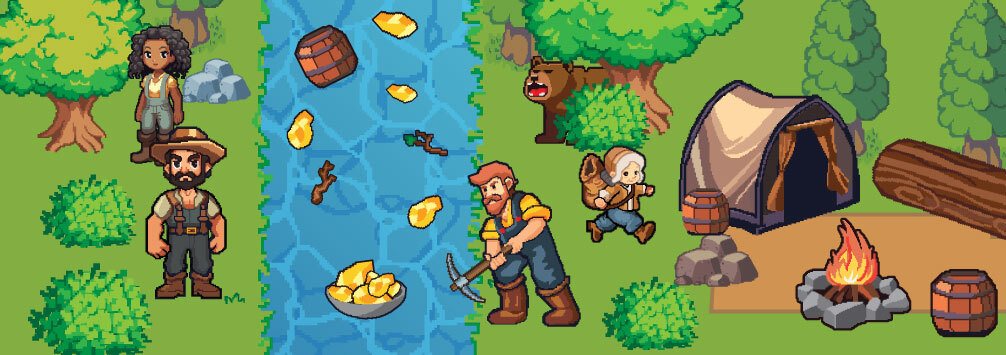
In the U.S. Mint Coin Classroom game, Gold Rush, players collect gold with the same tools used by miners during the California Gold Rush. This game is inspired by an important period in American and U.S. Mint history. Learn about how the real gold rush changed our country and our change!
Gold Fever
Well before the gold rush, rocks in the Sierra Nevada mountain range in northern California contained gold deposits. Over thousands of years, the rock eroded and freed pieces of gold to float down streams and collect in streambeds.
In one of those streambeds, workers at Sutter’s Mill discovered gold in January 1848. Soon, people from Oregon, Mexico, Hawaii, and China journeyed to the territory of California for their share of gold. The word spread slower to the eastern United States. By the end of the year, the U.S. government received the first gold samples, and President James K. Polk announced gold had been found in California. The news caused excitement throughout the country!
In 1849, thousands of prospectors flooded into California. These gold-seekers were nicknamed “49ers.”
In one year, the non-native population of California went from around 1,000 people to nearly 100,000. Many of these new settlers formed camps and small towns, removing the local native people from their homes. In 1850, President Millard Fillmore signed a bill that made California our 31st state.
Mining Tools
At the start of the California Gold Rush, prospectors used simple tools to separate the gold from the dirt, gravel, and sand. As gold became harder and harder to find, companies formed, using large-scale, destructive methods to pull the gold from the earth.
Pan
A gold pan was the simplest tool used by the early gold miners. The miner scooped gravel into the pan and swirled it with water. The lighter-weight dirt, sand, and gravel would wash out, leaving the heavier gold behind at the bottom of the pan. Using a pickaxe or shovel, the miner could loosen more dirt to scoop into the pan.
Rocker
Many miners also used a wooden rocker. The miner shoveled dirt and gravel into a box with a mesh sieve, then poured water over it. The gold would separate from the dirt and collect at the bottom. The box could also rock back and forth on rails, like a cradle, to help shake more of the gold free.
Sluice Box
Some miners built wooden sluice boxes to sort through larger amounts of dirt and gravel. As water and gravel was channeled through the sluice, the gold sank to the bottom. The rest of the rocks and dirt continued downstream.
Water Jet
Mint Branch Opened to Help Miners

After the miners found gold, they needed it made into coins. In 1854, the San Francisco Mint opened to process the huge amounts of gold. During its first year, the San Francisco Mint turned miners’ gold into over $4 million dollars in gold coins.
The most popular of these coins during the 1850s was the highest denomination, the double eagle, worth $20. The Mint created this denomination because of the large amounts of gold coming from California.
When miners brought their gold dust and nuggets to San Francisco, the Mint workers first melted it down. Melting separated out other metals that may have also been trapped in the nugget with the gold. The Mint could then make gold coins or gold ingots to return to the miner for spending or saving.
Today, the Mint still operates a location in San Francisco. The San Francisco Mint makes proof and commemorative coins.
The Cost of Mining
Gold mining in California changed the environment forever. Mining methods used increasingly destructive tools and practices.
In the areas where miners worked, rivers and streams became wider and wider as miners dug up the banks to look for gold. The rivers carried large amounts of sand, gravel, trees, and other materials downstream. This created blockages, which destroyed farms, buildings, and even towns. Miners also blew up and tunneled through mountains to find gold deposits. They dumped the debris in nearby waterways, burying streams and land completely in gravel. Poisonous mercury, used to free gold from rock, seeped into the land and water. All of these practices killed trees, plants, fish, and wildlife.
In 1884, a judge ruled that mining debris could not be released into waterways used by farming. This ruling made it difficult for mining to continue. Farming then became the largest industry in California.

